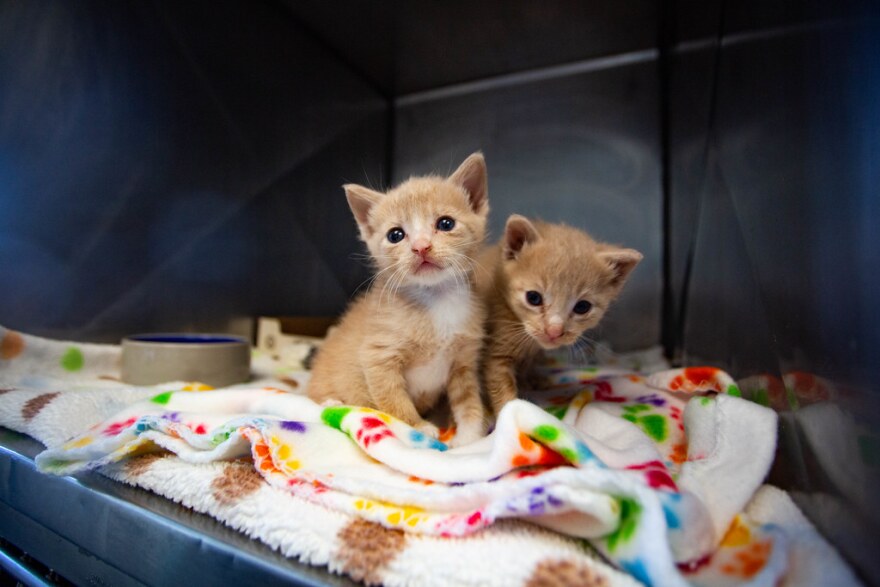Kitten season is upon us in Central Texas, and that means thousands — yes, thousands — of kittens will be born outdoors over the next few months. Austin shelters are already taking in a record number of tiny cats, and they want you to know how you can help.
Wait. There's a season of ... kittens?
Yes. Cats breed only in the warm months and because we live in Texas, those warm months stretch out from March to October — much longer than northern areas. And this year’s kitten season is off to roaring start.
The city’s three main animal shelters — Austin Animal Center, Austin Pets Alive and Austin Humane Society —each take in hundreds, if not thousands, of young kittens requiring critical care throughout kitten season. Each are reporting significantly higher intake so far this year.
Last year, for example, Austin Pets Alive took in an estimated 2,300 kittens. This year, it's already brought in 700 so far.
Austin Animal Center intakes about 2,000 kittens per season and is facing the same uptick.
“We have already gotten in 250 kittens under 2 months old this year,” a spokesperson for the Austin Animal Center said in an email. “And we are just about to start the really busy part of the season.”
Austin Humane Society, which took in 1,400 kittens last year, points out that as the climate stays warmer longer, the kitten season keeps extending, putting further strain on the shelter systems.

Look, kittens!
So, with an estimated 5,000 kittens predicted to be born outdoors in Austin this year, you may discover some teeny furballs in your neighborhood. And, yes, it will be tempting, but shelter staff warns to think twice before picking them up or bringing them inside.
Jennifer Parks, who runs the neonatal kitten foster program at Austin Pets Alive, says it's not necessarily dangerous for kittens to be born outside. Mama cats are quite savvy about setting their babies up in safe places and the kittens are likely OK.
“One thing to look for is the condition of the kittens. If they look clean and they don’t look skinny, they probably have a mom somewhere nearby,” Parks said.
Kittens are much more likely to survive if they are kept with their mom until they are weaned around 6 weeks of age.
“If you pick up the kittens and bring them into the shelter, not only will those kittens lose their mom and enter the shelter system, the mom cat will lose her kittens,” Parks said.
Austin Humane Society offers up this Found Kitten Flowchart to guide you if you happen upon a pile of kitties. And if the kittens are indeed abandoned or injured, you can reach out to any of the three shelters for guidance or call 311.
How else can you help
As the nation’s largest no-kill city, Austin's shelters work year-round to save and rehome animals. Kitten season adds to the strain.
Young kittens are the most vulnerable animals to cycle through the shelter systems, and they require intensive care.

There are several ways you can help.
Foster
All three shelters need fosters. Austin Pets Alive points out that it took more than 400 fosters to help with kitten season last year.
While fostering kittens can seem overwhelming, the shelter teams offer resources, including supplies and ongoing veterinary care. Famed internet kitten rescuer, Hannah Shaw aka the Kitten Lady, also publishes an encyclopedia of foster tutorials on her website.
Kittens can be adopted around 8 weeks old, so you won’t be fostering for too long. Once the kittens are nurtured to adoption age, they’ll likely get adopted fast. Austin Humane Society says adoptable kittens remain at the shelter on average fewer than two days.
Donate
Young kittens require round-the-clock care and special supplies to survive. Here are the shelters’ kitten season wishlists:
Each of the shelters also takes monetary donations — all day, everyday.
Adopt
Once kittens are old enough, they are spayed or neutered, vaccinated and ready for their new forever homes. Adoptable kittens are available at each shelter and at special events such as the AHS Kitten Shower.
Volunteer
Shelters always need volunteers. Volunteer info is available on their websites.
Trap-neuter-return
Austin is home to thousands of stray or free-roaming cats. These “community cats” live outdoors in colonies and are often not socialized to humans.
Austin Humane Society, in partnership with the Austin Animal Center, leads the city’s TNR efforts. Through the program, community cats are trapped, sterilized and vaccinated, and then returned to their neighborhoods.
Austinites can participate in the program by renting traps from the Austin Humane Society and taking community cats to the clinic for sterilization. There is no fee for the services. And if you see a stray cat with a tip clipped off its ear, know it has already been through the TNR program.
Spaying and neutering cats not only reduces disease and rowdy feline behavior, it also prevents overpopulated shelters. And when it comes to kitten season, prevention is key.














